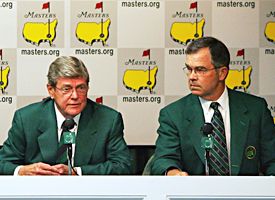"The second cut, yeah, if you go out there, you'll see it. That's all you need to change this golf course."
/Tiger Woods sat down with the scribes and while I'll leave it to Jaime Diaz to analyze the surprising number of references to late father Earl, let's get to the golf stuff. First, this rambling mess of question from someone with a strong British accent:
Q. Now that you have obviously entered the zone of extreme expectation, probably unprecedented in golf, does that affect you in any way? Are you able to shut out what people expect of you, or does it get to a point where you have to exclude it completely, or is it an incentive for you to be aware that people are expecting you to fulfill these extraordinary feats of consistency? Does it have any real impact on you as an individual?Okay, the golf course stuff is good:
Q. Is it safe to say that hitting long or whatever else, that's why you've done so well --Of course the club will read that and react with glee that you can't hit it in some bizarre place to open up an ideal angle. Got to toe that center line!
TIGER WOODS: You have to putt well here. You can't putt poorly here and win. Now, you have to drive the ball well in order to win here; before you could spray it all over the place and it didn't matter -- actually tried to spray it all over the place to give yourself the best angles. 9 you used to hit the ball so far right to give yourself an ankle up to those left pins; now with the added trees you can't really do that anymore.
The holes have changed over the years in that way. 17, sometimes you had to hit it to 15 to get to the back left pin just to get a shot at these angles; they have taken that away. It's playing a lot more different and a lot more penal off the tee but the greens are still the same. The greens are still just as penal.
Brace yourselves...
Q. I read the other day, Jack Nicklaus said, "I wish they would get rid of that rough up there." What rough is he talking about?
TIGER WOODS: The second cut, yeah, if you go out there, you'll see it. That's all you need to change this golf course.
Shots, for instance, on No. 1, if you pull it up the left side it used to run straight to the pine needles and you had no shot. Now it has a chance to get caught up, pull tee shots down 2 can get caught up. It changes the speed of this golf course quite a bit. Shots on 10, if you don't turn it, used to land up the right and actually roll through the gallery down into the trees and now it can get caught up.
Q. That much rough makes that much difference?
TIGER WOODS: Mm-hmm. (Nodding).
Good to see the scribes really thinking this stuff through before sitting down with Tiger.
Q. When Jack was in his prime, he wasn't a huge fan of playing in the Par 3 Tournament because he thought it was a distraction for him and he wanted to focus. Talk about your approach to the Par 3 and what you enjoy about it and your memories?
TIGER WOODS: My last one I played when Arnold, at the time, it was his last Masters. (Laughter) I made a hole-in-one and that was it. Good way to end it.
Q. You won't play tomorrow?
TIGER WOODS: No.
Q. Why?
TIGER WOODS: It's changed over the years. Used to be, I thought was a lot of fun to play, but now it is a little bit distracting to get ready and be ready for the tournament.
He's such a curmudgeon. I love it! Oh no, the guy asking about the rough is back...
Q. I would like to clarify a point on the rough, please. Some guys have said that it helps more than it hurts because it keeps the ball from running off into the trees. What's your feeling on that? Does it help you or hurt you, generally speaking.
TIGER WOODS: Well, I think it helps on tee shots, there's no doubt because it does slow the ball from going into the trees. But second shots, it does hurt you, because it's hard to control your distances on a golf course in which you have to be so precise, and if you're not with your distances, you're going to pay a pretty good price.
So, yes, it does help you off the tee, but certainly hinders you quite a bit going into the greens.
Tiger, don't bother. You're wasting your time.
















